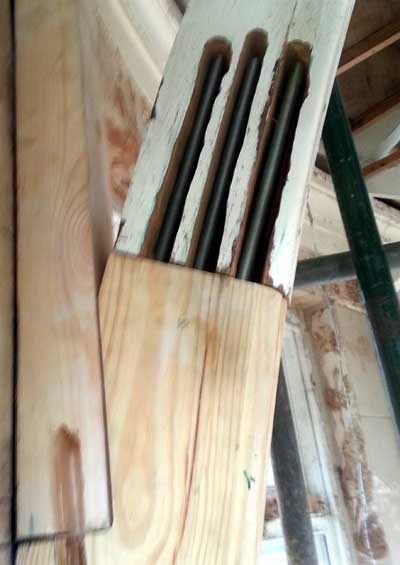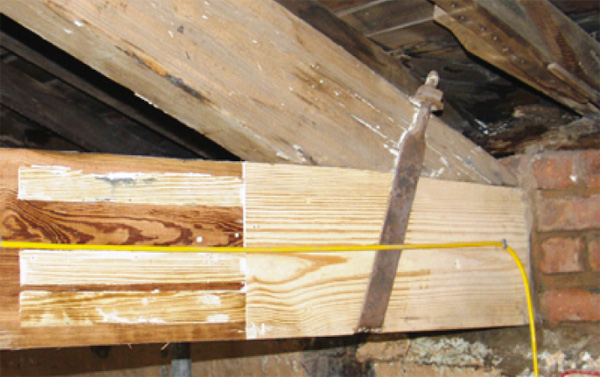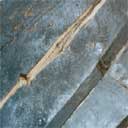Article - how to repair timber trusses and wooden floors
This project is presented by Property Repair Systems. We show you how to make Structural repairs to beams and other wooden components inside buildings without destroying sound timber.
Resin to be injected into slots in arch. After resin injection in a tie beam the slot covers have been sanded and the original strap refitted.
Additional Reading on this subject
Summary:
Repairing structural timbers - how to repair timber trusses, repair lintels, repair beams, fix joists, repair wall plates & repair rafters. Repairing shakes and splits in timber.
Wood floor repairs combined with beam repairs can save historic floors and reduce costs. If you need any help with any type of Structural timber repair, timber splits, shakes or cracks Property Repair Systems whose staff will be pleased to give you completely free, no obligation advice on 01626 872886 . The information you need may be in the project below. If not, call them for expert, impartial advice.
Repair of structural timbers has always been an expensive and time consuming operation. From a timber lintel in a Georgian terrace, to a huge tie beam in a barn conversion, if a new piece could not be spliced, or bolted on, the lot had to come out. Very often, even if it were possible to bolt a new section of timber on, the overlap for the bolts was so long it was almost like replacing the entire timber anyway. Property Repair Systems, which employs experts in all types of timber repairs and treatments, are happy to provide a free telephone help line for your queries regarding timber treatment and repair.
We are very pleased to introduce the wonderful new technology, the Timber-Resin Splice System. Removing complete timbers or carrying out traditional splices in joists, rafters and other structural timbers requires considerable opening up of ceilings, floors and roofs, and most people would rather not take their houses apart. In most cases complete replacement of a timber will be impossible by traditional means without scaffolding or roof removal, but a TRS will allow the Low Disturbance (and therefore cheaper) repair of beams, roof purlins, tie beams, lintels, joists and rafters. This method can even be used for repairing flag poles!
Using the Timber-Resin Splice System a section of timber can be cut out, in situ, and a new section added. The repair will be stronger than the original. How is this done? Obviously for the benefit of this project we have simplified the procedure. But not by much! It really is an uncomplicated breakthrough allowing new, treated timbers to be installed with the minimum of fuss and disturbance. Timbers are not all accessible from the same place. While you may be able to get to a floor joist from the top by lifting a section of the floor, it is far easier to access a rafter from underneath. Property Repair Systems has devised different ways of repairing structural timber, to allow access from all angles.
REPAIRING CRACKS, SPLITS AND SHAKES IN TIMBER.
Cracks in timber beams need not affect the overall integrity of the structure. Indeed, cracks in timber beams can be taken as a positive visual feature of the timber, which, in conjunction with the timber grain, distinguish timber from the more uniform man-made materials such as steel and concrete. The integrity of the timber can be called into question when it is impaired by cracks, splits and shakes and often it has required the replacement of a beam or rafter which has formed part of the original structure. This can now be overcome in a great many cases with the use of an injected epoxy resin. We recommend seeking the advice of a structural engineer for structural repairs.
Cracks, shakes, warps and fissures are formed as a result of the timber giving up moisture and shrinking. This may occur as part of initial drying or subsequent changes, during service, in the Equilibrium Moisture Content. The EMC of timbers inside buildings can range from 9% to 14%. Fibre saturation is reached in constructional softwoods at about 28 to 32%.
For cracks and splits that are greater than 5mm wide the void can be filled with an Mouldable Epoxy Putty, but if the crack penetrates more than 30% through the timber it will be necessary to provide dowels (Epoxy-Glass Bars) across the filled section in order to 'stitch' the two halves together. The advice of a Structural Engineer should be taken with regards to the number, diameter, length and spacing of the dowels. The dowels can be made of glass fibre, carbon fibre, steel or stainless steel. We recommend the use of epoxy/glass or epoxy coated steel, set in a Thixotropic Epoxy Injection Resin. Clean out cracks or splits with a saw blade and vacuum out all sawdust. Fill the cracks with Mouldable Epoxy Putty. When the Putty has set drill small holes, about 6mm in diameter through the epoxy into the back of the crack. Blow, or vacuum out the dust. Directly inject Thixotropic Epoxy Injection resin from the cartridge into the hole, until the resin flows from the adjacent hole. Continue until all the holes have been injected and cap off each with Mouldable Epoxy Putty.
Sand off any excess Putty and colour finish to suit the timber. If 'stitching' is required the cracked areas can now be cross drilled and epoxy-glass or steel rods fitted in Thixotropic Epoxy Injection resin.
Typical along the grain split in a carrier beam, caused by drying out. Close up of a timber crack in a rafter. Both can be resin repaired.
Technical Help
Property Repair Systems expert staff can help you with all kinds of timber repairs and are more than happy to give further information and advice.
Call 01626 872886 or E: Mail us help@propertyrepairsystems.co.uk
Property Repair Systems
T: 01626 872886
E: Mail us help@propertyrepairsystems.co.uk
Site written by: David Moore
David Moore, B.A. (Hons.), C.T.I.S., C.R.D.S. Technical Author
Google+
Other Property Repair Systems Sites:
www.boron.org.uk - how to use Boron based insecticides/fungicides to treat timber rots and insect attack
www.dampness-info.co.uk - how to treat penetrating dampness in walls and plaster
www.deck-treatment.co.uk - how to treat patio decks and yacht decks
www.dryrot.biz - how to kill Dry Rot in buildings
www.drywallandfloor.co.uk - membranes for lining damp walls, floors, basements and cellars
www.fire-door-paint.co.uk - upgrade doors to 30 minutes fire resistance
www.joist-repair.co.uk - how to quickly repair joists and beams of any size
www.propertyrepairsystems.co.uk - our Home Site
www.steel-fire-paint.co.uk - treat steel with Intumescent Paint to provide fire protection
www.timber-repair.co.uk - how to repair timber beams
www.woodworm-info.co.uk - how to kill and prevent woodworm and death watch beetle
www.woodworm-expert-advice-forum.org.uk - all your questions and our answers about woodworm treatment DIY



